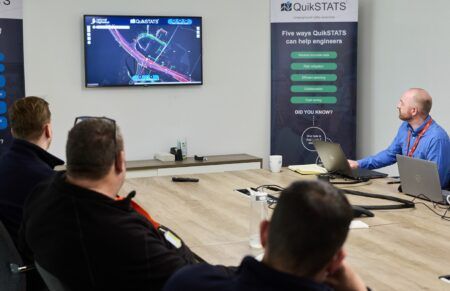Siemens and the South Coast Air Quality Management District (SCAQMD) are conducting a one-mile, zero-emission eHighway demonstration in Carson, California, near the ports of Los Angeles and Long Beach.
Three big-rig trucks hauling freight are running along the stretch of highway that uses Siemens technology to electrify select highway lanes via an overhead catenary or pantograph system.
The roof-mounted connection supplies the trucks with electric power, similar to how modern-day trolleys or streetcars are powered on many city streets, and the system also allows for truck operation outside of the electrified sections of infrastructure.
The pantograph can connect and disconnect automatically with the power line via a sensor system while the trucks are moving. This allows the eHighway trucks to easily switch lanes or pass other vehicles without being permanently fixed to the overhead system.
To further ensure the same flexibility as conventional trucks, the eHighway vehicles use an electric-hybrid drive system, which can be powered either by diesel, compressed natural gas (CNG), battery or other onboard energy source, when driving outside of the catenary lines.
One battery-electric truck, a clean natural-gas hybrid-electric truck and a diesel-hybrid truck are now driving on a one mile-long (1.6km) catenary system on the north- and south-bound lanes of South Alameda Street in Carson.
Heavy-duty trucks are the number one source of smog-forming emissions in Southern California, so developing a zero- or near-zero goods movement system in the ports will reduce toxic and greenhouse gas emissions in communities around the ports.
The system is expected to lower fossil fuel consumption, reduce truck operating costs, substantially reduce emissions, and help accommodate the growing reliance on freight transportation. The aim of this specific project is to demonstrate the eHighway system applied in truck operation on public roads in an urban USA setting and to further prepare applications for larger scale initiatives in the future, which may include some level of autonomous operation.
“Experts expect global CO? emissions from road freight traffic to more than double by 2050,” said Andreas Thon, head of turnkey projects and electrification at Siemens. “This electrified truck system can modernize the existing infrastructure using the latest technology to accommodate the growing amount of freight travel, reduce emissions, and keep these ports competitive.”
Wayne Nastri, SCAQMD’s executive officer, added, “This demonstration of zero-emission cargo movement could lead to the deployment of eHighway systems that will reduce pollution and benefit public health for residents living near the ports.”




